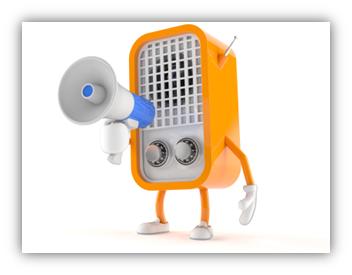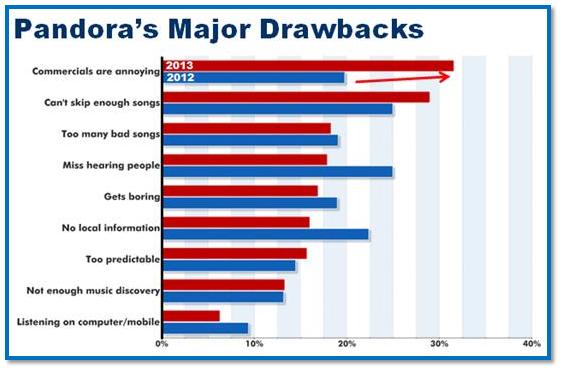 Users have probably felt it for some time. Now it’s been confirmed: Pandora has been sneaking in more commercial units.
Users have probably felt it for some time. Now it’s been confirmed: Pandora has been sneaking in more commercial units.
This will sound familiar because it’s been a broadcast radio tactic since Marconi…or Mel Karmazin. Station sales staffs have consistently worked at the margins to squeeze in as many spots in as possible, flirting with the tipping point. The trick is in the balance, and it’s never an easy task in an industry where there’s simply a limited amount of inventory and seemingly insatiable revenue goals.
Back in those high-flying Infinity days where there never seemed to be a stated spot load (“Just make goal”), a monopolistic radio industry could get away with abusing an audience with commercials. Where else could they go to hear the newest Rock, the best Country, and their favorite talk shows? And that mentality was turbocharged by consolidation, encouraging broadcasters to try to get away with more commercials in an environment with few options for listeners.
Enter the great equalizer – the Internet. Once consumers got a taste of free music via streaming channels, YouTube, and a myriad of other options, the pressure on broadcasters to moderate their commercial loads intensified.
Today, FM radio stations need to establish that “difference” – their raison d’être – in order to justify 12 minutes of commercials an hour: the local flavor, compelling DJs, meaningful community involvement, entertainment value.
And then there’s Pandora. It was recently revealed by outgoing CEO Joe Kennedy that, in fact, the biggest pure-play music service has been stealthily adding units to its music programming. As he explained on a recent analyst call, “We have been very gradually increasing the overall ad load… our strategy is to very gradually grow that audio ad load over time and that continues to be the case.”
Good luck with that because every PD in America has heard that logic. It never stops… until it reaches the point where too many commercials clearly impact listening, consumer enjoyment, and eventually the brand.
And there may be indications that Pandora has already reached that threshold. Last year in Techsurvey8, the biggest barrier to listening to Pandora was the lack of DJs and limited song skips. In this year’s Techsurvey9, it’s commercials.
JacoBLOG readers have seen this telling chart before, but it is an important reminder of how quickly the sands can shift. As Pandora encounters new competitors in the pure-play space, their ability to juggle their commercial load could be a deciding factor.
But broadcasters shouldn’t gloat about this dose of Pandora radio reality. The onus is on AM and FM stations to achieve that value proposition where consumers see a realistic trade-off between entertainment and information and the commerce that pays for it all.
“Playing favorites from the ‘80s, ‘90s, and today” isn’t likely to make the cut in a world where consumers demand – and get – more.
- A 2020 Lesson?It Could All Be Gone In A Flash - April 24, 2025
- How AI Can Give Radio Personalities More…PERSONALITY - April 23, 2025
- Can Radio Afford To Miss The Short Videos Boat? - April 22, 2025





Everything is relative and Pandora has nothing to lose by adding units. They’re paying roughly 60 cents on the dollar in royalties and haven’t been able to turn a meaningful profit yet, despite commanding a significantly higher CPM than radio. So what other option do they have? As it turns out, Pandora may have some leverage – the above chart shows that dissatisfaction with lack of local info and personalities has dropped by almost as much as its grown over the bigger commercial load.
They key is, of course, to find the balance – the point that maxes out revenue. And in Pandora’s case, the ideal place to be might not be the one with the most listeners, because they pay incrementally for each one. So a somewhat smaller, more ad tolerant listener base might be Pandora’s sweet spot.
The bigger question is whether ad supported music is viable in the long term. If Pandora has to get to say, 8 minutes an hour to reach a theoretical profit, my guess is that there is no workable model for them – that 8 minutes will prove unbearable to its audience that got used to a minute or two from them. And radio wouldn’t be able to survive on 8 minutes an hour either, because it couldn’t generate enough revenue there.
Maybe its time to rethink the whole model.
Great comments, Bob, about balance. In Pandora’s case, I’m thinking that some of their challenge emanates from the original value proposition – for how many users is a commercial-free experience a critical factor? And how many commercials is a deal-breaker? I’m sure they’re doing their own internal research to determine that tipping point. Thanks for the perspective.
I’m surprised an innovative platform like pandora can’t go the same route when it comes to generating revenue . They’re probably not getting a good amount of subscribers to their ad free platform so I’m surprised they don’t try to market that more , wether its with strategic partnerships like Sirius did with car manufacturers or just plain tv spots and billboards broadcasting that message . I find it hard to believe the 25 -49 demo would not find that appealing , especially in this age of crazy spot loads and vanilla programming that exists. In today’s major markets with all the consolidation and voice tracking . The fact that they had to go to traditional commercials is pretty sad .
On the flip side though it d be great to dream about a day when radio can figure out how to double their margins while decreasing their spot loads . There has to be a model that exists for a station that is so compelling and viral that the audience transcends the market to a level that there would be value in banner ads and non audio billboards enough to sustain revenue goals … I guess there would have to be a CEO who truly believes in creative and artistic branding principles .
Oh to dream
Fc
Frank, it’s a tough putt to invent a new revenue model, even for Pandora. I fondly recall Pirate Radio’s failed attempt to use sponsored hours. And then there’s public radio, moving faster toward grants, foundations, and member contributions. It can’t be too long before an innovative progressive station uses the Kickstarter model to fund itself. Thanks for thinking this through and for reading our blog.
Interesting read Fred. Begs a question…how does HBO, Netflix, et al do such strong and (mostly) profitable work….while Pandora, FB,I-heart and the like can’t turn a stock price or a profit.
My thoughts…HBO (and similar) was never, ever free. Started and maintained as a premium product. Everything else was free no trying to change to a paid or ad supported model. Thoughts?
I think that’s a big factor, Dave. Part of that original value proposition was FREE. It’s hard to turn that around without alienating a big portion of the fan base. Thanks for the perspective an for reading our blog.
These are all such great comments, and responses by Fred – I, for one, would rather listen to “free” radio than a paid subscription – even when I had free XM in my new Ford – once the “free” 6 months was up, I didn’t subscribe – I just went back to radio, and actually – really value the “local” content much more. Where else can you drive down the road and hear an ad for a local store – see the store, and be able to walk in and say, “I heard your ad”?
Fred has been speaking my language for a long time – and when I listened to Pandora – I too have felt interrupted by commercials that are just that, an interruption to what I believed was supposed to just be a free music stream…..
Thanks for the kind words, Kelly, and your observations. Much appreciated.